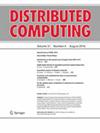有理平均度r∈(3.5,4)的h=1的无限族((2h+32))-交临界图的书嵌入
IF 1.3
4区 计算机科学
Q3 COMPUTER SCIENCE, THEORY & METHODS
引用次数: 0
摘要
在交叉临界图的构造中使用的一个主要工具是瓦片。在瓦片概念中,瓦片可以通过将一个瓦片以线性或圆形的方式粘合到另一个瓦片来布置。圆形瓷砖系列形成了一个无限图形族。通过这种方式,可以确定该图族的交集数。在本研究中,形成了一个平均阶数r在3.5~4之间的无限族图Q(1,s,b)(n)。通过以圆形方式将瓦片P(1,s,b)的许多副本粘合在一起而形成的图,其中瓦片P(2,s,c)由两块相同的瓦片组成。然后,将图形嵌入到书中,确定可以形成的页码。当把图形嵌入书中时,顶点放在一条称为书脊的线上,边放在称为页面的半平面上。结果表明,图Q(1,s,b)(n)具有10个交叉临界,图的书嵌入具有4页书。文章信息:收到时间:2020年7月13日修订后收到时间:2019年8月29日在线发布时间:2021年1月5日本文章由计算机程序翻译,如有差异,请以英文原文为准。
Book Embedding of Infinite Family ((2h+3 2))-Crossing-Critical Graphs for h=1 with Rational Average Degree r∈(3.5,4)
A principal tool used in construction of crossing-critical graphs are tiles. In the tile concept, tiles can be arranged by gluing one tile to another in a linear or circular fashion. The series of tiles with circular fashion form an infinite graph family. In this way, the intersection number of this family of graphs can be determined. In this research, has been formed an infinite family graphs Q(1,s,b)(n) with average degree r between 3.5 and 4. The graph formed by gluing together many copies of the tile P(1,s,b) in circular fashion, where the tile P(1,s,b) consist of two identical pieces of tile. And then, the graph embedded into the book to determine the pagenumber that can be formed. When embed graph into book, the vertices are put on a line called the spine and the edges are put on half-planes called the pages. The results obtained show that the graph Q(1,s,b)(n) has 10-crossing-critical and book embedding of graph has 4-page book. ARTICLE INFO: Received : 13 July 2020 Received after revision : 29 August 2020 Available online : 5 January 2021
求助全文
通过发布文献求助,成功后即可免费获取论文全文。
去求助
来源期刊

Distributed Computing
工程技术-计算机:理论方法
CiteScore
3.20
自引率
0.00%
发文量
24
审稿时长
>12 weeks
期刊介绍:
The international journal Distributed Computing provides a forum for original and significant contributions to the theory, design, specification and implementation of distributed systems.
Topics covered by the journal include but are not limited to:
design and analysis of distributed algorithms;
multiprocessor and multi-core architectures and algorithms;
synchronization protocols and concurrent programming;
distributed operating systems and middleware;
fault-tolerance, reliability and availability;
architectures and protocols for communication networks and peer-to-peer systems;
security in distributed computing, cryptographic protocols;
mobile, sensor, and ad hoc networks;
internet applications;
concurrency theory;
specification, semantics, verification, and testing of distributed systems.
In general, only original papers will be considered. By virtue of submitting a manuscript to the journal, the authors attest that it has not been published or submitted simultaneously for publication elsewhere. However, papers previously presented in conference proceedings may be submitted in enhanced form. If a paper has appeared previously, in any form, the authors must clearly indicate this and provide an account of the differences between the previously appeared form and the submission.
 求助内容:
求助内容: 应助结果提醒方式:
应助结果提醒方式:


